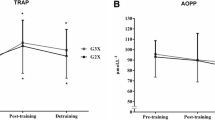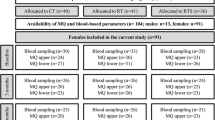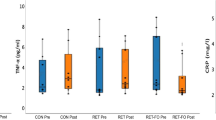Abstract
Current recommendations aimed at reducing neuromuscular and functional loss in aged muscle have identified muscle power as a key target for intervention trials, although little is known about the biological and cardiovascular systemic response in the elderly. This study investigated the effects of 12 weeks of low-frequency, moderate-intensity, explosive-type resistance training (EMRT) on muscle strength and power in old community-dwelling people (70–75 years), monitoring functional performance linked to daily living activities (ADL) and cardiovascular response, as well as biomarkers of muscle damage, cardiovascular risk, and cellular stress response. The present study provides the first evidence that EMRT was highly effective in achieving a significant enhancement in muscular strength and power as well as in functional performance without causing any detrimental modification in cardiovascular, inflammatory, and damage parameters. Moreover, trained elderly subjects showed an adaptive response at both systemic and cellular levels by modulation of antioxidant and stress-induced markers such as myeloperoxidase (MPO), heat shock protein 70 (Hsp70) and 27 (Hsp27), and thioredoxin reductase 1 (TrxR1).



Similar content being viewed by others
References
Aagaard P, Suetta C, Caserotti P, Magnusson SP, Kjaer M (2010) Role of the nervous system in sarcopenia and muscle atrophy with aging: strength training as a countermeasure. Scand J Med Sci Sports 20:49–64
Baeckle TR, Earle RW (2008) Essentials of strength training and conditioning, 3rd edn. Human Kinetics, Champaign
Bassey EJ, Fiatarone MA, O'Neill EF, Kelly M, Evans WJ, Lipsitz LA (1992) Leg extensor power and functional performance in very old men and women. Clin Sci (Lond) 82:321–327
Bean JF, Leveille SG, Kiely DK, Bandinelli S, Guralnik JM, Ferrucci L (2003) A comparison of leg power and leg strength with the in CHIANTI study: which influences mobility more? J Gerontl Med Sci 58A:728–733
Buford TW, Cooke MB, Willoughby DS (2009) Resistance exercise-induced changes of inflammatory gene expression within human skeletal muscle. Eur J Appl Physio 107:463–471
Caserotti P, Aagaard P, Larsen JB, Puggard L (2008) Explosive-heavy resistance training in old and very old adults: changes in rapid muscle force, strength and power. Scand J Med Sci Sports 18:773–782
Chung HY, Cesari M, Anton S et al (2009) Molecular inflammation: underpinnings of aging and age-related diseases. Ageing Res Rev 8:18–32
Cole CR, Foody JM, Blackstone EH, Lauer MS (2000) Heart rate recovery after submaximal exercise testing as a predictor of mortality in a cardiovascularly healthy cohort. Ann Intern Med 132:552–555
de Vos NJ, Singh NA, Ross DA, Stavrinos TM, Orr R, Fiatarone Singh MA (2005) Optimal load for increasing muscle power during explosive resistance training in older adults. J Gerontol A Biol Sci Med Sci 60:638–647
English D, Andersen BR (1974) Single-step separation of red blood cells. Granulocytes and mononuclear leukocytes on discontinuous density gradients of Ficoll-Hypaque. J Immunol Methods 5:249–252
Fauzi F, Budin SB, Azwan SS, Yuen LK (2007) The effect of 5-week exercise program on oxidative stress and response to acute exercise among sedentary subjects. Jurnal Sains Kesihatan Malaysia S2:39–52
Fehrenbach E, Passek F, Niess AM, Pohla H, Weinstock C, Dickhut H (2000) HSP expression in human leukocytes is modulated by endurance exercise. Med Sci Sports Exerc 32:592–600
Ferri A, Narici M, Grassi B, Pousson M (2006) Neuromuscular recovery after a strength training session in elderly people. Eur J Appl Physiol 97:272–279
Fielding RA, Vellas B, Evans WJ et al (2011) Sarcopenia: an undiagnosed condition in older adults: prevalence, etiology and consequences. International working group on sarcopenia. J Am Med Dir Assoc 12:249–256
Goraya TY, Jacobsen SJ, Pellikka PA et al (2000) Prognostic value of treadmill exercise testing in elderly persons. Ann Intern Med 132:862–870
Hairi NN, Cumming RG, Naganathan V et al (2010) Loss of muscle strength, mass (sarcopenia) and quality (specific force) and its relationship with functional limitations and physical disability: the Concord Health and Ageing in Men Project. J Am Geriatr Soc 58:2055–2062
Hakkinen K, Kraemer WJ, Newton RU, Alen M (2001) Changes in electromyographic activity, muscle fibre and force production characteristics during heavy resistance/power strength training in middle-aged and older men and women. Acta Physiol Scand 171:51–62
Henwood TR, Taaffe DR (2005) Improved physical performance in older adults undertaking a short-term programme of high-velocity resistance training. Gerontology 51:108–115
Izquierdo M, Aguado X, Gonzalez R, López JL, Häkkinen K (1999) Maximal and explosive force production capacity and balance performance in men of different ages. Eur J Appl Physiol Occup Physiol 79:260–267
Jetté M, Sidney K, Blümchen G (1990) Metabolic equivalents (METS) in exercise testing, exercise prescription, and evaluation of functional capacity. Clin Cardiol 13:555–565
Jones DT, Pugh CW, Wigfield S, Stevens M, Harris AL (2006) Novel thioredoxin inhibitors paradoxically increase hypoxia-inducible factor-A expression but decrease functional transcriptional activity, DNA binding, and degradation. Clin Cancer Res 12:5384–5394
Jouven X, Empana JP, Schwartz PJ (2005) Heart-rate profile during exercise as a predictor of sudden death. N Engl J Med 352:1951–1958
LaRoche DP, Millett ED, Kralian RJ (2011) Low strength is related to diminished ground reaction forces and walking performance in older adults. Gait Posture 33:668–672
Larsen HA, Caserotti P, Puggaard L, Aagaard P (2011) Stair-ascent performance in elderly women: effect of explosive strength training. JAPA 19:117–136
Levinger I, Goodman C, Peake J et al (2009) Inflammation, hepatic enzymes and resistance training in individuals with metabolic risk factors. Diabet Med 26:220–227
Loria V, Dato I, Graziani F, Biasucci LM (2008) Myeloperoxidase: a new biomarker of inflammation in ischemic heart disease and acute coronary syndromes. Mediators Inflamm 135625.
Mergener M, Martins MR, Antunes MV et al (2009) Oxidative stress and DNA damage in older adults that do exercises regularly. Clin Biochem 42:1648–1653
Messinger-Rapport B, Pothier Snader CE, Blackstone EH (2003) Value of exercise capacity and heart rate recovery in older people. J Am Geriatr Soc 51:63–68
Miller NJ, Rice-Evans C, Davies MJ, Gopinathan V, Milner A (1993) A novel method for measuring antioxidant capacity and its application to monitoring the antioxidant status in premature neonates. Clin Sci (Lond) 84:407–412
Mitchell WK, Williams J, Atherton P, Larvin M, Lund J, Narici M (2012) Sarcopenia, dynapenia, and the impact of advancing age on human skeletal muscle size and strength; a quantitative review. Front Physiol 3:1–18
Narici MV, Maffulli N (2010) Sarcopenia: characteristics, mechanisms and functional significance. Br Med Bull 95:139–159
Phillips MD, Flynn MG, McFarlin BK, Stewart LK, Timmerman KL (2010) Resistance training at eight-repetition maximum reduces the inflammatory milieu in elderly women. Med Sci Sports Exerc 42:314–325
Reid KF, Fielding RA (2011) Skeletal muscle power: a critical determinant of physical functioning in older adults. Exerc Sport Sci Rev 40:4–12
Rietjens SK, Beelen M, Koopman R et al (2007) A single session of resistance training induces oxidative damage in untrained men. Med Sci Sports Exerc 39:2145–2151
Sheikhani H, Babaee Beygi MA, Daryanoosh F, Jafari B (2011) Alteration of plasma brain natriuretic peptide level after acute moderate exercise in professional athlete. Int Cardiovasc Res J 5:148–150
Skelton DA, Greig CA, Davies JM, Young A (1994) Strength, power and related functional ability of healthy people aged 65–89 years. Age Ageing 23:371–377
Squadrone R, Rodano R, Preatoni E (2012) Comparison of velocity and power output data derived from an inertial based system and an optical encoder during squat lifts in a weight room setting. J Sports Med Phys Fitness 52:40–46
Stephens SW, Khanolkar MP, Bain SC (2009) The biological relevance and measurement of plasma markers of oxidative stress in diabetes and cardiovascular disease. Atherosclerosis 202:321–329
Stewart LK, Flynn MG, Campbell WW et al (2007) The influence of exercise training on inflammatory cytokines and C-reactive protein. Med Sci Sports Exerc 39:1714–1719
Suzuki T, Bean JF, Fielding RA (2001) Muscle power of the ankle flexors predicts functional performance in community dwelling older women. J Am Geriatr Soc 49:1161–1167
Thompson PD (1996) The cardiovascular complications of vigorous physical activity. Arch Intern Med 156:2297–2302
Towbin H, Staehelin T, Gordon J (1979) Electrophoretic transfer of proteins from polyacrylamide gels to nitrocellulose sheets: procedure and some applications. Proc Natl Acad Sci U S A 76:4350–4354
Ungvari Z, Csiszar A, Kaley G (2004) Vascular inflammation in aging. Herz 29:733–740
Venojärvi M, Aunola S, Puhke R, Marniemi J, Hämäläinen H, Halonen JP, Lindström J, Rastas M, Hällsten K, Nuutila P, Hänninen O, Atalay M (2008) Exercise training with dietary counselling increases mitochondrial chaperone expression in middle-aged subjects with impaired glucose tolerance. BMC Endocr Disord 27(8):3
Vignali DA (2000) Multiplexed particle-based flow cytometric assays. J Immunol Methods 21(243):243–255
Voorrips LE, Ravelli AC, Dongelmans PC, Deurenberg P, Van Staveren WA (1991) A physical activity questionnaire for the elderly. Med Sci Sports Exerc 23:974–979
Weiner DA, Ryan TJ, Parsons L et al (1995) Long-term prognostic value of exercise testing in men and women from the Coronary Artery Surgery Study (CASS) registry. Am J Cardiol 75:865–870
Acknowledgments
This work was supported by grants from the University of Rome “Foro Italico” (Research 2009) to D. C. The Lazio Regional Municipality (Agreement CRUL-Lazio n. 12650/2010) supported the post-doc scholarship to ID.
Conflict of interest
Each author of this study further declares no relationships with the companies or manufacturers who will benefit from the results of the present study. The authors of this article declare no conflicts of interest.
Author information
Authors and Affiliations
Corresponding author
Additional information
Maria Reyes Beltran Valls and Ivan Dimauro contributed equally to this research.
About this article
Cite this article
Beltran Valls, M.R., Dimauro, I., Brunelli, A. et al. Explosive type of moderate-resistance training induces functional, cardiovascular, and molecular adaptations in the elderly. AGE 36, 759–772 (2014). https://doi.org/10.1007/s11357-013-9584-1
Received:
Accepted:
Published:
Issue Date:
DOI: https://doi.org/10.1007/s11357-013-9584-1




